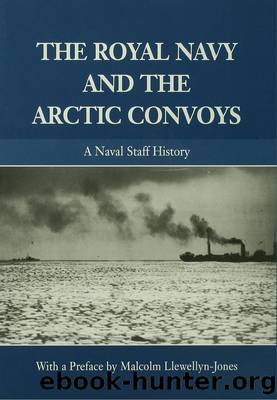The Royal Navy and the Arctic Convoys by Malcolm Llewellyn-Jones

Author:Malcolm Llewellyn-Jones [Llewellyn-Jones, Malcolm]
Language: eng
Format: epub
ISBN: 9780415861779
Barnesnoble:
Publisher: Taylor & Francis
Published: 2014-08-15T00:00:00+00:00
39
The disastrous passage of Convoy PQ 17 tended to throw into the background the fortunes of the westbound convoy, QP 13. This convoy of 35 ships sailed in two parts from Archangel and Murmansk, joining up at sea on 28th June under Commodore N. H. Gale. Its escort consisted of five destroyers, the Inglefield (Commander A. G. West. S.O.). Achates. Volunteer, Intrepid and O.R.P. Garland, the A.A. ship Alynbank and eight smaller craft.57
Thick weather prevailed during most of the passage, but the convoy was reported by enemy aircraft on 30th June while still east of Hear fsland and again on 2nd July. No attacks developed, however, and that afternoon Convoy PQ 17 was passed, to which the enemy then transferred their attentions.
After an uneventful passage. Convoy QP 13 divided off the north-east coast of Iceland on 4th July in compliance with directions from the Admiralty,58 Commodore Gale with 16 merchant ships turning south for Loch Ewe, while the remaining 19 ships continued round the north coast of Iceland for Reykjavik. Captain J. Hiss, master of the United States ship American Robin, was nominated as Commodore of this section on parting company. At 1900, 5th July, Captain Hissâ convoy formed in five columns and escorted by the minesweepers Niger (Commander A. J. Cubison, S.O.) and Hussar, the Free French Corvette Roselys, and the trawlers Lady Madeleine and St. Elstan,59 was approaching the north-west corner of Iceland. The weather was overcast, visibility about one mile; wind N.E., force 8; sea rough. No sights had been obtained since 1800, 2nd July, and the position was considerably in doubt.
At 1910, Commander Cubison suggested that the front of the convoy should be reduced to two columns in order to pass between Straumnes and the minefield to the north-west of Iceland. This was the first the Commodore had heard of the existence of the minefield.
Soon afterwards, Commander Cubison gave his estimated position at 2000 as 66° 45ⲠN., 22° 22ⲠW.60 and suggested altering course to 222° for Straumnes point at that time. This was done. About two hours later (2200). the Niger, which had gone ahead to try and make a landfall, leaving the Hussar as a visual link with the convoy, sighted what she took to be North Cape bearing 150° one mile, and ordered the course of the convoy to be altered to 270°. Actually, what the Niger had sighted was a large iceberg, but this was not realised for some time; at 2240. she blew up and sank with heavy loss of life, including Commander Cubison. Five minutes later a last signal from her, explaining the mistaken landfall and recommending a return to course 222°, was handed to Captain Hiss. But it was too late; already explosions were occurring among the merchant ships. The westerly course had led straight into the minefield. Considerable confusion prevailed, some thinking a U-boat attack was in progress, others imagining a surface raider. Four ships were sunk61 and two seriously damaged.62 Good rescue work was carried out by the escorts, especially the Roseleys (Lieutenant de vaisseau A.
Download
This site does not store any files on its server. We only index and link to content provided by other sites. Please contact the content providers to delete copyright contents if any and email us, we'll remove relevant links or contents immediately.
| Africa | Americas |
| Arctic & Antarctica | Asia |
| Australia & Oceania | Europe |
| Middle East | Russia |
| United States | World |
| Ancient Civilizations | Military |
| Historical Study & Educational Resources |
The Boy, the Mole, the Fox and the Horse by Charlie Mackesy(2890)
Fatal Storm by Rob Mundle(2097)
Iced In by Chris Turney(1891)
Erebus by Michael Palin(1745)
Alone by Richard E. Byrd(1631)
The White Darkness by David Grann(1623)
South with the Sun by Lynne Cox(1478)
Mawson's Will by Lennard Bickel(1375)
Caroline Alexander by The Endurance: Shackleton's Legendary Antarctic Expedition(1311)
Big Dead Place: Inside the Strange and Menacing World of Antarctica (Large Print 16pt) by Nicholas Johnson(1307)
South by Ernest Henry Shackleton(1268)
The Stowaway by Laurie Gwen Shapiro(1255)
South Pole by Elizabeth Leane(1222)
In the Kingdom of Ice by Hampton Sides(1210)
The Ice Master by Jennifer Niven(1179)
A Farewell to Ice: A Report from the Arctic by Peter Wadhams(1169)
Ice by Unknown(1166)
The Ice Balloon: S. A. Andree and the Heroic Age of Arctic Exploration by Wilkinson Alec(1121)
Frozen in Time by John Geiger & John Geiger(1108)
